History
It is probable that the diocese of Acqui was established at the end of the fourth century, about the same time, it would appear, as the dioceses of Novara, Turin, Ivrea, Aosta and perhaps, Asti and Alba.
The first undoubted bishop of Acqui was Ditarius. A tablet found in 1753 in the church of St. Peter, indicates that Ditarius, bishop of Acqui, died on 25 January 488, in the Consulate of Dinamias and Syphidius. [4]
Popular tradition gives Deusdedit, Andreas, Severus, Maximus, and, earliest of all, Majorinus, as bishops prior to him. Majorinus probably lived either at the end of the fourth, or in the beginning of the fifth, century. [5] The name was very common in the third, fourth, and fifth centuries. [6] Veneration was offered to the saint from time immemorial by the church in Acqui, shown by his statues and relics. This veneration, however, has ceased since a decree of the Congregation of Rites (8 April 1628) prohibited the veneration of saints whose sanctity had not been declared by the Holy See.
In the list of the bishops of Acqui appears Saint Guido (1034–70), who was said to be a member of the family of the Counts of Acquesana, [7] under whose patronage the cathedral was erected. [8] He is the patron saint of Acqui. [9]
Acqui and Alessandria
In 1068 the new city of Alessandria, named in honor of Pope Alexander III, was created, with the object of countering the political maneuvers of the Emperor Frederick Barbarossa. In 1070 a delegation was sent to Rome, which presented the city to the Pope as a vassal of the Holy Roman Church. In 1075, Pope Alexander erected a new diocese at Alessandria, and provided its first bishop, Arduinus. The territory of the new diocese was taken from that of the diocese of Acqui. In 1180, Archbishop Algisius of Milan, acting on authority delegated to him by Pope Alexander, decreed the union of the two dioceses in the person of Bishop Uberto Tornielli of Acqui, who would take the title of Bishop of Alessandria, but the arrangement was acceptable neither to the people of Acqui nor to Bishop-elect Otto of Alessandria, and therefore the union did not take effect.
The new diocese of Alessandria, however, supported the Emperor Otto IV against the Papacy, and therefore in 1202 [10] Pope Innocent III suppressed the diocese of Alessandria and reunited its territory to the jurisdiction of the diocese of Acqui. The bishop was ordered to live six months at Acqui and six months at Alessandria. [11]
Friction developed between Bishop Uberto, who was in favor of the union, and the Chapter of the Cathedral of Acqui, who envisioned the loss of their status and prerogatives if the bishop should move to Alessandria. Bishop Uberto therefore appealed to the Pope on 16 February 1205. On 16 May, Pope Innocent III sent representatives to Piedmont to bring about the union, [12] deciding that the bishop would be called the Bishop of Alessandria and Acqui. Their work was ratified by the Pope. [13] Bishop Uberto began to use the double title. [14] Bishop Uberto, however, was caught in some simonical transactions with regard to churches in both dioceses which were not under episcopal control, and he was suspended by Innocent III from his functions on 12 October 1211. His repentance was apparently unsatisfactory, since Pope Innocent accepted his resignation from his episcopal functions on 12 November 1213. [15]
Acqui and Alessandria were united until 1405, until the diocese of Alessandria was re-erected. Pope Innocent VII (Roman Obedience) appointed Fra Bertolino of Alessandria as the new bishop on 14 April 1405. [16]
Synods
A diocesan synod was an irregularly held, but important, meeting of the bishop of a diocese and his clergy. Its purpose was (1) to proclaim generally the various decrees already issued by the bishop; (2) to discuss and ratify measures on which the bishop chose to consult with his clergy; (3) to publish statutes and decrees of the diocesan synod, of the provincial synod, and of the Holy See. [17]
A set of canons ('capitula') was issued jointly by Archbishop Ottone Visconti (1262–1295) of Milan and Bishop Alberto (1258–c. 1270) of Acqui in 1265, perhaps in connection with a provincial or diocesan synod, or both. [18] Bishop Oddonus (1305–c. 1340) held a diocesan synod which concluded on 10 April 1308, and issued, with the consent of the Cathedral Chapter, a set of canons which were concerned mostly with clerical conduct and the proper administration of the sacraments, as well as limitations on the participation of lay persons in the election or installation of clergy. [19]
Bishop Bonifacio de Sismondi (1427–1450) conducted three diocesan synods during his term: the first opened on 10 February 1429; the second in 1432, which dealt with financing the attendance of the bishop at the Council of Basel; and the third in 1440. He also began the construction of the episcopal palace, for which money had been left by his predecessor, Bishop Enrico. [20]
Pope Sixtus IV was committed to the idea of yet another crusade against the Turks. He launched his project in the spring of 1475 by demanding a 10% tax on the income of the clergy. On 13 April 1475 he wrote to Bishop Thomas de Regibus of Acqui, naming him papal Nuncio and Collector of Papal Revenues in the entire Marquisate of Monferrat, and granting him the powers necessary to make the collection from all church institutions (including Chapters, monasteries, Priories, and convents) and persons (from Patriarchs and Archbishops down to simple clerics), administrators, and officials, both exempt from normal episcopal jurisdiction and not exempt; lay persons were to contribute 3 ⅓%, and Jews 5%. [21]
In 1477 Bishop de Regibus held a diocesan synod in the Cathedral of Acqui, from the 3rd to the 19th of October. [22]
In 1480 Bishop Thomas de Regibus was compelled to appeal to the pope when three of the castles in his diocese which formed part of the episcopal income were seized by Antoniotto Malaspina, a layman of the diocese of Acqui. Pope Sixtus IV in response ordered the Archpriest of the neighboring diocese of Asti to investigate the matter. [23]
A diocesan synod was held by Bishop Ludovico Bruni (1499–1508), and a set of thirty-nine canons of entirely traditional content was published from the Cathedral of Acqui on 22 August 1499. [24]
Bishop Giuseppe Maria Sciandra (1871–1888) held a diocesan synod on 5–7 September 1876. [25]
Cathedral and Chapter
The original cathedral of the diocese of Acqui was at the church of S. Pietro. The new cathedral, dedicated to the Virgin Mary, was begun by Bishop Primus (c. 989–1018) in the Lombard style, and became the cathedral of the diocese under Bishop Dudo (c. 1024–1033), who transferred the Canons from S. Pietro, and converted S. Pietro into a monastic foundation. A donation charter of 1042 mentions both the monastery of S. Pietro and the Chapter house of S. Maria. [26] Work on the cathedral was completed in 1167, and Bishop Guido (1034–1070) consecrated the entire edifice. [27] His hagiographical life, with perhaps some exaggeration, says that he built the Cathedral of S. Maria with his own funds, and had Bishop Petrus of Tortona and Albertus (Obertus) of Genoa consecrate the edifice on 11 (or 13) November 1167. [28]
The Cathedral of Acqui was served by a Chapter, composed of three dignities and (in 1675) nine Canons. [29] In 1744 there were twelve Canons. [30] By 1844 there were fifteen Canons. The dignities were: the Provost, the Archdeacon, and the Archpriest. [31]
In the 15th century there were evidently problems with the Chapter in maintaining a regular system of public worship in the Cathedral. An agreement was entered into in 1455 by the Canons with Bishop Thomas de Regibus, but the provisions had not been carried out. A new agreement to prevent this dereliction of duty was sworn to with Bishop Constantinus Marenchi on 11 October 1486, binding both those canons who were present and those who happened to be absent from the meeting. [32]
In 1495 Bishop Marenchi dedicated the new cathedral cloister and houses for the Canons and other clergy who served the Cathedral. [33]

The Diocese of Alba Pompeia or Alba Pompea is a Latin Church ecclesiastical territory or diocese of the Catholic Church in Italy. Its territory comprises eighty towns in the civil Province of Cuneo and two in the Province of Asti.

The Diocese of Saluzzo is a Latin diocese of the Catholic Church in the Piedmont region of northwestern Italy, centered in the comune of Saluzzo. The diocese was established on 29 October 1511 for political reasons, to transform the Marquisate of Saluzzo into an ecclesiastic territory, and was directly dependent upon the Holy See. It is now a suffragan of the Archdiocese of Turin.

The Archdiocese of Turin is a Latin Church ecclesiastical territory of the Catholic Church in Italy.
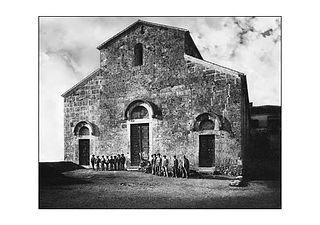
The Roman Catholic diocese of Ferentino existed until 1986, when it was united into the new diocese of Frosinone-Veroli-Ferentino.

The Diocese of Bergamo is a Latin diocese of the Catholic Church in Italy, and is a suffragan of the Archdiocese of Milan. Geographically, Bergamo stood between the mainland interests of the Republic of Venice, and the territory of the Duchy of Milan. The duchy was regularly contested by the French and the Holy Roman Empire, which brought about repeated military operations. Internally, from the 12th to the 15th century, there was the usual party strife between the Guelphs, who generally supported the political and religious policies of the Papacy; and the Ghibellines, who generally supported the Emperors. As Kings of Italy, the emperors were feudal overlords of Lombardy.
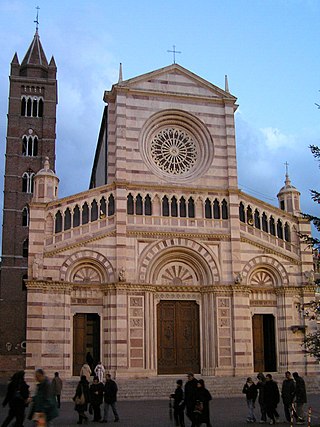
The Diocese of Grosseto is a Latin Church diocese of the Catholic Church in Italy, a suffragan of the archdiocese of Siena-Colle di Val d'Elsa-Montalcino, in Tuscany. Its current bishop is Giovanni Roncari, OFMCap.
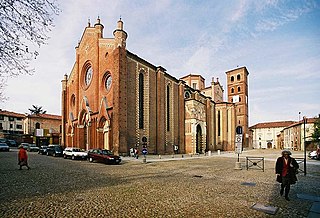
The Diocese of Asti is a Latin diocese of the Catholic Church in Piedmont, northern Italy, centered in the city of Asti. It has been a suffragan of the Archdiocese of Turin since 1515. Previous to that, it was a suffragan of the Archdiocese of Milan.
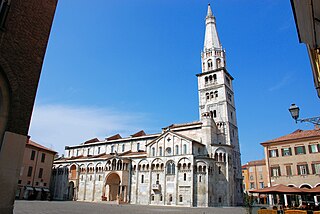
The Archdiocese of Modena–Nonantola is a Latin archdiocese of the Catholic Church in Italy. It existed as the Diocese of Modena in central Italy from the 4th century. Originally it was a suffragan the diocese of Milan, but later became a suffragan of Ravenna. Because of the schism of the Antipope Clement III, Pope Paschal II released Modena from obedience to the church of Ravenna, but Pope Gelasius II restored the previous status. Modena continued as a suffragan of Ravenna until 1582, when the Archdiocese of Bologna was created by Pope Sixtus V in the Bull Universi orbis of 1 December 1582, and was assigned Modena as one of its suffragans.

The Diocese of Orvieto-Todi is a Latin Church ecclesiastical territory or diocese of the Catholic Church in central Italy. It was created in 1986 when the historical Diocese of Orvieto was united to the Diocese of Todi. The Diocese of Orvieto-Todi is immediately exempt to the Holy See and not part of any ecclesiastical province.
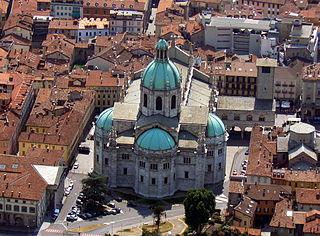
The Diocese of Como is a Latin Church ecclesiastical jurisdiction or diocese of the Catholic Church in northern Italy. It was established in the Fourth Century. It is a suffragan diocese in the ecclesiastical province of the metropolitan Archdiocese of Milan. The Bishop of Como's cathedra is in the Como Cathedral.

The Diocese of Foligno is a Latin Church ecclesiastical territory or diocese of the Catholic Church in Umbria, Italy. It is a suffragan diocese in the ecclesiastical province of the metropolitan Archdiocese of Perugia-Città della Pieve.

The Diocese of Tortona is a Latin Church ecclesiastical territory or diocese of the Catholic Church in Northern Italy, spanning parts of three regions of Piedmont, Lombardy and Liguria. It is a suffragan diocese in the ecclesiastical province of the metropolitan Archdiocese of Genoa and forms part of the ecclesiastical region of Liguria. The diocese claims to be one of the oldest in Lombardy and the Piedmont.

The Roman Catholic diocese of Bobbio was an Italian bishopric which existed from 1014 until 1986. The diocese was formed from the territory of the Abbey of Bobbio.
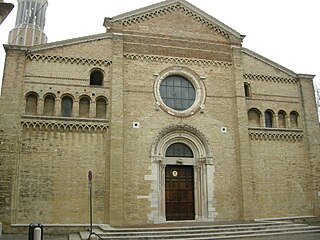
The Diocese of Fano-Fossombrone-Cagli-Pergola is a Latin diocese of the Catholic Church in Italy, created in 1986, when the historical Diocese of Fano was united to the Diocese of Cagli e Pergola and the Diocese of Fossombrone. It is a suffragan of the Archdiocese of Pesaro.

The Diocese of Melfi-Rapolla-Venosa is a Latin diocese of the Catholic Church in Basilicata, southern Italy. In 1986 the historic Diocese of Melfi-Rapolla was united with the Diocese of Venosa. The diocese is a suffragan of the Archdiocese of Potenza-Muro Lucano-Marsico Nuovo. The Abbey of the Santissima Trinità at Venosa comes under the Diocese.

The Diocese of Sessa Aurunca is a Latin diocese of the Catholic Church in southern Italy. Since 1979 it has been a suffragan of the Archdiocese of Naples.

The Diocese of Anagni-Alatri is a Latin Church ecclesiastical territory or diocese of the Catholic Church in Lazio, Italy. It has existed in its current form since 1986. In that year the Diocese of Alatri was united to the historical Diocese of Anagni. The diocese is immediately exempt to the Holy See.
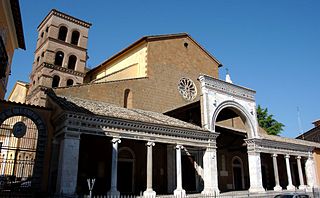
The Diocese of Civita Castellana is a Latin Church ecclesiastical territory or diocese of the Catholic Church in Latium, central Italy. It has existed in the current form since 1986, when the Diocese of Nepi e Sutri was united into the Diocese of Civita Castellana, Orte e Gallese. The Diocese of Gallese had been added to the Dioceses of Civita Castellana and Orte in 1805. The name of the diocese was shortened in 1991, in accordance with Vatican policies. The diocese of Civita Castellana is immediately exempt to the Holy See.

The Diocese of Alessandria is a Latin diocese of the Catholic Church in Piedmont, northern Italy. Originally a suffragan of the Archdiocese of Milan, since 1817 it has been a suffragan of the Archdiocese of Vercelli.

The Roman Catholic Diocese of Lipari was a Latin diocese of the Roman Catholic Church located in the town of Lipari in the Aeolian Islands of Sicily, Italy. The diocese consists of the entire island of Lipari as well as seven smaller adjacent islands. It is now incorporated into the Archdiocese of Messina-Lipari-Santa Lucia del Mela.





















